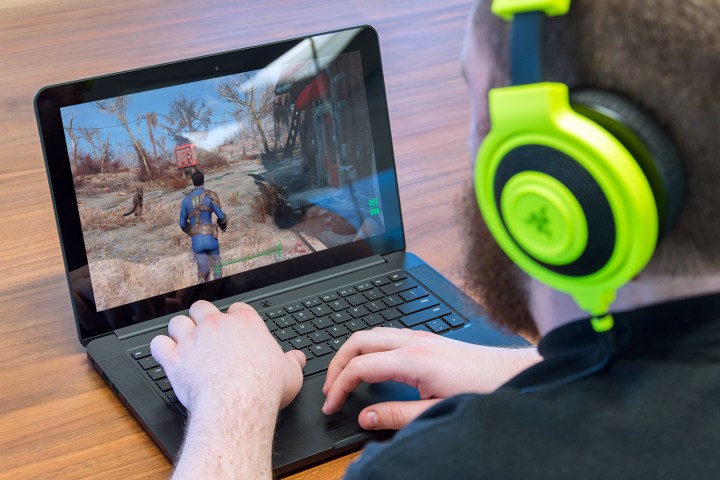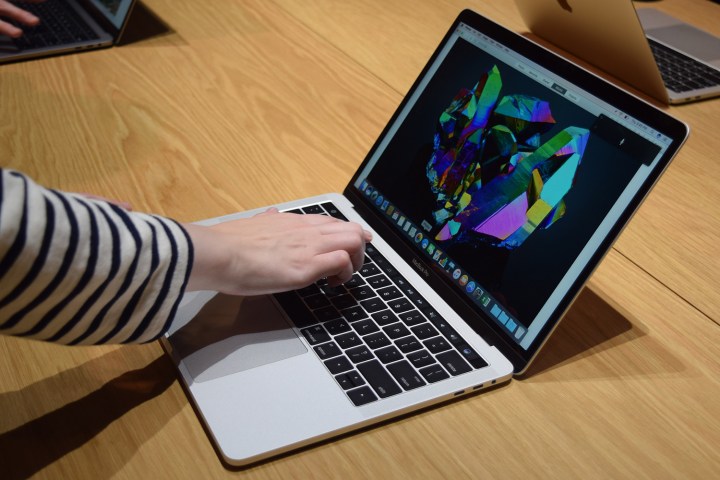Here are our picks for the best laptops for programming.
Dell XPS 13
The best programming laptop overall

Many programmers simply love Dell’s XPS ultrabooks. They’re thin and light and pack enough horsepower to get the job done. You can even get them loaded with Ubuntu if you’re into that sort of thing. It falls short of our desire for a discrete graphics chip, but it makes up for that shortcoming with the latest Intel processor, lots of speedy storage, and a QHD+ screen with one of the thinnest bezels you can find on a laptop. If you need something with some graphics prowess, upgrade to the XPS 15, which comes with a GTX 1050 Ti.
On this model you’ll find Intel’s eighth-generation Core i7-8550U processor and integrated graphics powering a 13.3-inch touch-capable screen with a 3,200 x 1,800 resolution. Backing the processor is 16GB of LPDDR3 system memory clocked at 1,866MHz, and 512GB of storage on a speedy PCIe NVMe M.2 SSD. All of this is crammed into a lightweight form factor that measures 0.60 inches at its thickest point and weighs a mere 2.7 pounds.
Razer Blade
Best programming laptop for games

The Razer Blade is built for PC gamers, manufactured by a company that focuses on gaming hardware and peripherals. But programmers love this device given it’s sleek, powerful, and rather professional in appearance. That said, there’s not a lot of visual bling as seen with other
With this laptop, Razer provides two starting points: One with a 1,920 x 1,080 resolution and one with a 3,840 x 2,160 resolution. Your storage options depend on these screens: 256GB, 512GB, or 1TB with the Full HD option, and 512GB or 1TB with the UHD option. All three storage selections rely on PCIe NVMe M.2 stick-shaped SSDs for fast boot and program load times.
Backing this screen is Intel’s Core i7-7700HQ processor, Nvidia’s GeForce GTX 1060 discrete graphics chip for mobile, and 16GB of DDR4 system memory clocked at 2,400MHz. The keyboard supports Razer’s Chroma lighting platform packing 16.8 million colors, meaning any connected Chroma-supported Razer device will synchronize its colors and lighting effects with the laptop.
Apple MacBook Pro 16
Best Apple programming laptop

For fans of Apple, you can’t go wrong with the MacBook Pro and all the power crammed into the 16-inch model.
Apple’s MacBook Pro is served up in two size, but here we chose the larger 16-inch unit. We like the Silver or Space Gray model packing Intel’s 6-core 9th Gen Intel Core i7 processor and AMD’s Radeon Pro 5300M discrete GPU (4GB). If that’s not enough graphics prowess, it can be configured with the meatier Radeon Pro 5600M GPU. The base model also includes 16GB of RAM and 512GB on a speedy SSD.
Other notable features include four Thunderbolt 3 ports (charging, DisplayPort, USB 3.2 Gen2), a 720p FaceTime HD camera, a backlit keyboard, Bluetooth 4.2, and Wireless AC connectivity. The audio consists of two stereo speakers with a high dynamic range, a 3.5mm headphone jack, a three-mic array, and support for Dolby Atmos playback.
The battery promises up to 30 days of standby time (10 hours of movie playback).
Google Pixelbook
Best programming Chromebook

For those who prefer a Linux-based option with easy third-party software integration, built-in security and virus protection, and automatic updates, Google’s Pixelbook is calling your name. Users can have their cake and eat it too by running Chrome OS and Android apps alongside sandboxed Linux desktop programs.
Google’s Pixelbook features an older 7th Gen i5 or i7 processor, a 12.3-inch display with 2400 x 1600 resolution, 8GB or 16GB of RAM, and a 10-hour battery that delivers two hours of run-time on 15 minutes of charge. The default amount of storage is 128GB, though you can configure up to 256GB or 512GB if needed.
Google Pixelbook can be deployed in four different modes, including tent, tablet, entertainment, and laptop. For those interested in drawing or other apps that require a stylus, the Pixelbook Pen provides natural drawing, note-taking, and other functions. The Gorilla Glass and aluminum exterior reduce the overall weight and help cool the laptop.